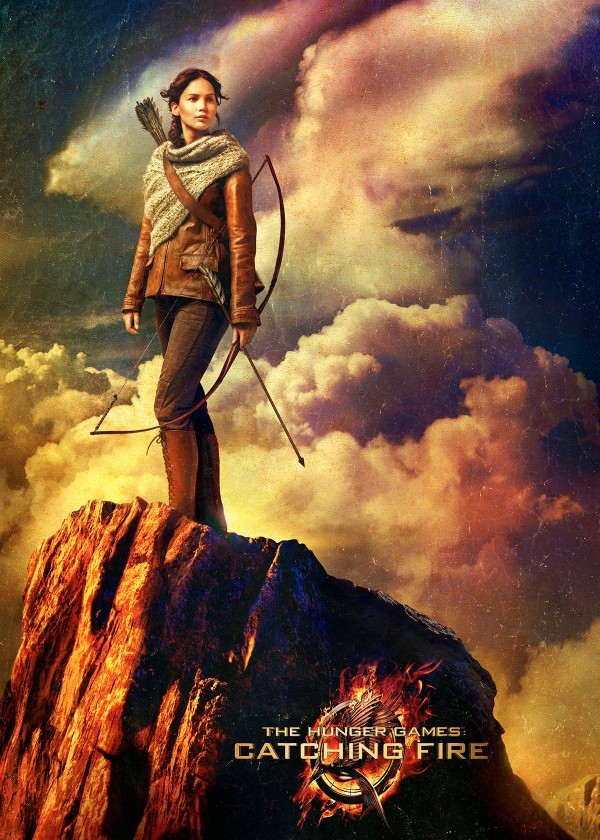THE HUNGER GAMES: CATCHING FIRE (2013, directed by Francis Lawrence, 146 minutes, U.S.)
DALLAS BUYER’S CLUB (2013, directed by Jean-Marc Vallée, 117 minutes, U.S.)
BY DAN BUSKIRK FILM CRITIC The dystopia thickens in the second installment of The Hunger Games: Catching Fire. What’s ablaze in this chapter is the popularity of Katniss (current “It Girl” Jennifer Lawrence), the main character of the series who won the government’s murderous gladiator game in the first film by threatening double-suicide with her last opponent at the contest’s climax. This development made Katniss a reality TV star and an inspiration to the revolutionaries who seek to bring down the all-seeing/all-controlling government. Although the leaders would like to dispense with Katniss immediately, they instead seek to disgrace her in the eyes of her admirers and crush the rebellion.
Catching Fire jumps right into the story with both feet first, wasting no time in catching audiences up with the events laid down by one of last year’s biggest hits, which grossed over a half-billion dollars. The plot is now starting to resemble the original Star Wars trilogy, with Katniss as the Luke figure who holds the key to helping the rebellion bring down the evil empire. Like the original trilogy’s mid-chapter, The Empire Strikers Back, Catching Fire deepens its characters and leaves them in the lurch at its climax, but best of all it reassures its viewers that the producers of this franchise know what they are doing by bringing the Hunger Games story to the screen with more than a touch of finesse.
The exaggerated Victorian fashions of the ruling caste from the first film has now morphed into a sexier 70s “Glam Rock” look that separates them from the gray lower classes. They’ve also replaced director Gary (Pleasantville) Ross with the more action-fluent Francis Lawrence, who previously helmed Will Smith’s I Am Legend and the adaptation of Water For Elephants. Lawrence brings a streamlined pace to the proceedings and keeps the emotions expressive amidst the second half’s endless action.
Where the first film set the stage, Catching Fire broadens the scope of this world and begins to point the way for Katniss to bring the casually heartless overlords down. A few more seasoned actors are pulled into the mix too, including Amanda Palmer as a babbling former games winner and Oscar winner Philip Seymour Hoffman as the seemingly nefarious game designer Plutarch Heavensbee (the goofily metaphoric names are one of the few things that betray the film’s youth novel roots.)
Pop hits like The Hunger Games are most resonant when they touch upon current fears and obsessions and the post-Snowden knowledge of our surveillance state gives the story a growing relevancy. When Katness’ hometown suitor steals a kiss in a back alley, the ominous President Snow ( a glowering Donald Sutherland) enjoys re-running the tape to show Katniss that no moment in her life is private. If made a decade ago, Katniss’ desire to bring down the all-seeing rulers might have brought up memories of Germany’s Stasi but today it doesn’t take much imagination to see the Hunger Games‘ evil empire as the same governmental force that is gutting our Fourth Amendment today. Ominously, The Hunger Games has come to resemble a mirror held up to the darkening present and less a fictional reality show within a book/movie franchise about some distant dystopian future. To quote the Chamber’s Brothers, time has come today.
– – – – – – – – – – – – –
We’re rooting for Ron Woodroof too, although he does make it a little harder. He’s a homophobic, combative, dick-driven Texan who has contracted  AIDS in the year of 1985 and he comes to the realization the government-supported AZT treatment is more dangerous then helpful. Given weeks to live, Ron quickly adopts a “Fuck-the-World” attitude as he pursues and distributes a variety of untested medicines that bring the ire of the FDA down hard.
AIDS in the year of 1985 and he comes to the realization the government-supported AZT treatment is more dangerous then helpful. Given weeks to live, Ron quickly adopts a “Fuck-the-World” attitude as he pursues and distributes a variety of untested medicines that bring the ire of the FDA down hard.
Matthew McConaughey continues his campaign to make us forget a decade of fluffy rom-coms as he looks to shed his easy-going hunk persona and climb the pedestal of “serious actors.” He’s nearly unrecognizable here as the raw-boned Woodroof, his laidback Texas drawl charged with the urgency of a sick man who is looking death in face. Along the way he throws his lot in with the transgendered Rayon (an unrecognizable Jared Leto) and overcomes his prejudice while bringing needed medications to a desperate and growing clientèle.
McConaughey’s performance is pure Oscar bait, and worthy too as he refuses to completely sand down the gruff exterior of a do-gooder with more than a little self-interest wrapped up in his motivation. Canadians Jean-Marc Vallée and Yves Bélanger give the film a wonderful burnt-out Texas feel as director and cinematographer respectively, including some haunting scenes where Woodroof summons the repressed memory of the swinging behavior that he suspects infected him with the disease. Acting, directing, it is all there, and the film’s historical view of the epidemic is valuable but the movie’s shortcoming is in the under-written script that can’t supply the momentum the story needs. Woodroof travels the world to find the drugs and government agents throw up roadblocks but the situation has little to build towards and Woodroof’s driven personality only has so many dimensions.
We have a grudging respect for Woodroof not laying down and accepting his death sentence but selling untested drugs to desperate men in motel rooms suggests a moral ambiguity that the script simply doesn’t have the depth to embrace. Is Woodruff simply an unrestrained free market capitalist or reckless profiteer at the dawn of a sex-borne plague? Further cluttering things, Jennifer Garner seems sort of shoehorned into the story as well, giving us a sweet-faced concerned women to direct our concern for the morally-cloudy Woodroof. The rich performances of McConaughey and Leto take us as far as they can but ultimately these strung-out characters are no joy to hang out with and after two hours their heroic tragedy ends up taking more than it gives.

